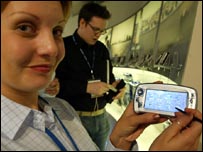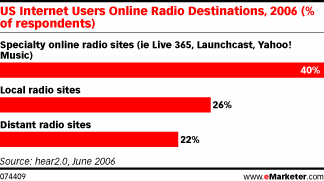"A adesão em massa de músicos a lugares como o Myspace, dando música a ouvir, ou mesmo oferecendo ficheiros mp3, mostra-se cada vez mais capaz de cativar público que o velho FM", diz Nuno Galopim, no texto de abertura de um dossier sobre a música na internet (suplemento «6ª», DN, 10/3/06)
ALguns excertos que mostram que a rádio, a rádio musical, está e vai perder influência não apenas do ponto de vista de quem está interessado em promover-se (os músicos e as editoras) mas também de quem está interessado em conhecer - nesse sentido, para que servirá a rádio musical?
»Whatever People Say I Am, That's What I'm Not, dos Arctic Monkeys, é a estreia discográfica com o maior sucesso de sempre no mercado blitânico. Na primeira semana, o álbum atingiu a generosa marca de 360 mil cópias vendidas, mantendo oscArctic Monkeys nas primeiras páginas da imprensa musical britânica e exportando a sua música para os EUA com relativo sucesso. Os Arctic Monkeys apostaram numa nova forma de divulgação. Em cada uma das actuações, a banda distribuia, gratuitamente, uma gravação dos seus temas e encorajava todos os presentes a fazer circular o disco pela Internet. Sucesso garantido muito antes de qualquer edição oficial, manobra de marketing ou investimento multinacional. (...) Depois de anos de namoros ilegais, de acções judiciais e proibições, os músicos tornaram-se eles próprios utilizadores do ciberespaço e assumiram, sem preconceitos, as vantagens que o meio oferece em tempos de incerteza, relativamente ao futuro da indústria discográfica. (...) O "método" mais recente é a utilização da Rede como forma de interacção com um público que os músicos ainda não conhecem, mas que com ele estabelecem uma relação de superior proximidade. O Myspace.com lidera este fenómeno, uma espécie de fórum em que cada utilizador registado pode dar-se a conhecer como bem entender, utilizando fotos, textos ou, no caso dos músicos, canções. São já muitos os que por ali se fixam, revelando temas, recolhendo opiniões e divulgando notícias ou concertos. O feedback é imediato e global"». («Música com rede», pág 6, TP)
«Antes de tudo, está alojado em www.myspace.com acessível a qualquer intemauta, até por não se tratar de um domínio exclusivamente dedicadoà música. O princípio passa por estabelecer uma rede de amigos, através de uma comunidade pessoal onde é possível enviar mensagens privadas, deixar comentários ou adicionar outras pessoas. Na "secção" de música, passa-se exactamente o mesmo, com a possibilidale das bandas poderem colocar quatro mp3, para audição, ou descarga, actualizar notícias e contar um pouco da sua história. Simples e prático, num meio termo entre site e blogue. No Myspace estão representados alguns dos majores nomes da actualidade, embora por vezes se tratem de criações de fãs. Mas há excepções; o Myspace dos Duran Duran é oficial e distingue-se pelos inéditos colocados não só na página principal como em subpáginas. Se exceptuarmos bandas consagradas, o número de grupos novos que se regista neste domínio é ainda maior» («Pessoal e transmissível, pág 7, DP).

